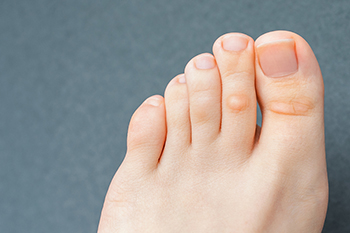Connect With Us
Blog
Items filtered by date: March 2022
Supportive Shoes and Exercise May Help Flat Feet
 When a patient talks about having fallen arches, they are referring to the condition that is known as flat feet. This is noticeable while standing on the floor, and both feet lie completely flat. There are several reasons why this ailment may occur, including genetics, an injury to the foot or ankle, or medical conditions that can include arthritis. Additionally, obesity, diabetes, and the aging process may cause flat feet. A common symptom many patients notice is foot pain. This can be a result of strained ligaments and muscles this condition may cause. Relief may be found when supportive shoes are worn, and it may help to practice specific exercises. If you have flat feet, it is suggested that you speak with a podiatrist who can guide you toward relief processes.
When a patient talks about having fallen arches, they are referring to the condition that is known as flat feet. This is noticeable while standing on the floor, and both feet lie completely flat. There are several reasons why this ailment may occur, including genetics, an injury to the foot or ankle, or medical conditions that can include arthritis. Additionally, obesity, diabetes, and the aging process may cause flat feet. A common symptom many patients notice is foot pain. This can be a result of strained ligaments and muscles this condition may cause. Relief may be found when supportive shoes are worn, and it may help to practice specific exercises. If you have flat feet, it is suggested that you speak with a podiatrist who can guide you toward relief processes.
Flatfoot is a condition many people suffer from. If you have flat feet, contact Eugene Little, DPM from Foot and Ankle Centers of Ohio. Our doctor will treat your foot and ankle needs.
What Are Flat Feet?
Flatfoot is a condition in which the arch of the foot is depressed and the sole of the foot is almost completely in contact with the ground. About 20-30% of the population generally has flat feet because their arches never formed during growth.
Conditions & Problems:
Having flat feet makes it difficult to run or walk because of the stress placed on the ankles.
Alignment – The general alignment of your legs can be disrupted, because the ankles move inward which can cause major discomfort.
Knees – If you have complications with your knees, flat feet can be a contributor to arthritis in that area.
Symptoms
- Pain around the heel or arch area
- Trouble standing on the tip toe
- Swelling around the inside of the ankle
- Flat look to one or both feet
- Having your shoes feel uneven when worn
Treatment
If you are experiencing pain and stress on the foot you may weaken the posterior tibial tendon, which runs around the inside of the ankle.
If you have any questions please feel free to contact our office located in Sidney, OH . We offer the newest diagnostic and treatment technologies for all your foot and ankle needs.
What to Do When You Have a Corn on Your Foot
 Corns are like calluses in that they develop from friction on the skin. They are hard, thick patches of skin that usually occur on the feet. Though corns are not serious, they can become irritated and painful. Different types of corns can develop on the feet – hard (the most common), soft, and seed corns. Hard corns are hard, as the name implies, and usually occur on wider areas of thick skin. Soft corns are more likely to be rubbery in texture, are white or gray in color, and are more apt to develop between toes. Seed corns are usually found on the bottom of the foot. Each of these types of corns can hurt as they thicken. Treatment for corns is often as simple as eliminating the source of friction that caused them in the first place. Make sure shoes and socks fit well and are not too loose or tight, trim toenails regularly so they do not push toes up against shoes and moisturize feet to prevent dry skin. If a corn develops, corn pads help to protect from irritation at its site. If a corn is unusually painful, does not go away, or seems infected, or if you have another physical condition that can lead to a greater problem (such as diabetes or peripheral arterial disease), a visit to a podiatrist is suggested for proper evaluation and treatment.
Corns are like calluses in that they develop from friction on the skin. They are hard, thick patches of skin that usually occur on the feet. Though corns are not serious, they can become irritated and painful. Different types of corns can develop on the feet – hard (the most common), soft, and seed corns. Hard corns are hard, as the name implies, and usually occur on wider areas of thick skin. Soft corns are more likely to be rubbery in texture, are white or gray in color, and are more apt to develop between toes. Seed corns are usually found on the bottom of the foot. Each of these types of corns can hurt as they thicken. Treatment for corns is often as simple as eliminating the source of friction that caused them in the first place. Make sure shoes and socks fit well and are not too loose or tight, trim toenails regularly so they do not push toes up against shoes and moisturize feet to prevent dry skin. If a corn develops, corn pads help to protect from irritation at its site. If a corn is unusually painful, does not go away, or seems infected, or if you have another physical condition that can lead to a greater problem (such as diabetes or peripheral arterial disease), a visit to a podiatrist is suggested for proper evaluation and treatment.
If you have any concerns regarding your feet and ankles, contact Eugene Little, DPM of Foot and Ankle Centers of Ohio. Our doctor will treat your foot and ankle needs.
Corns: What Are They? and How Do You Get Rid of Them?
Corns can be described as areas of the skin that have thickened to the point of becoming painful or irritating. They are often layers and layers of the skin that have become dry and rough, and are normally smaller than calluses.
Ways to Prevent Corns
There are many ways to get rid of painful corns such as wearing:
- Well-fitting socks
- Comfortable shoes that are not tight around your foot
- Shoes that offer support
Treating Corns
Treatment of corns involves removing the dead skin that has built up in the specific area of the foot. Consult with Our doctor to determine the best treatment option for your case of corns.
If you have any questions please feel free to contact our office located in Sidney, OH . We offer the newest diagnostic and treatment technologies for all your foot and ankle needs.
Read more about Understanding Corns and CallusesAre You Suffering From Ingrown Toenails?
Your Feet are the Body’s Workhorse
 The main job of the many bones, muscles, ligaments and tendons of the foot is to get you where you want to go. When you take a step, and most of us do this without really thinking about it, the heel touches the ground and absorbs some of the force. The muscles in the sole of the foot then give way, and the band of tissue beneath (plantar fascia) stretches out. Next, your weight shifts to the ball of the foot, and finally the toes push off the surface. Your weight is now fully on the foot, and you start the process again with the other foot. You can do several things to keep your feet operating as they should: A) Wear shoes that fit properly, have plenty of room in the toe box, and have low heels; B) Maintain a healthy body weight; and C) go for walks regularly to keep the foot muscles strong and flexible. If you experience any problems walking, it’s a good idea to see a podiatrist for a thorough examination.
The main job of the many bones, muscles, ligaments and tendons of the foot is to get you where you want to go. When you take a step, and most of us do this without really thinking about it, the heel touches the ground and absorbs some of the force. The muscles in the sole of the foot then give way, and the band of tissue beneath (plantar fascia) stretches out. Next, your weight shifts to the ball of the foot, and finally the toes push off the surface. Your weight is now fully on the foot, and you start the process again with the other foot. You can do several things to keep your feet operating as they should: A) Wear shoes that fit properly, have plenty of room in the toe box, and have low heels; B) Maintain a healthy body weight; and C) go for walks regularly to keep the foot muscles strong and flexible. If you experience any problems walking, it’s a good idea to see a podiatrist for a thorough examination.
If you have any concerns about your feet, contact Eugene Little, DPM from Foot and Ankle Centers of Ohio. Our doctor can provide the care you need to keep you pain-free and on your feet.
Biomechanics in Podiatry
Podiatric biomechanics is a particular sector of specialty podiatry with licensed practitioners who are trained to diagnose and treat conditions affecting the foot, ankle and lower leg. Biomechanics deals with the forces that act against the body, causing an interference with the biological structures. It focuses on the movement of the ankle, the foot and the forces that interact with them.
A History of Biomechanics
- Biomechanics dates back to the BC era in Egypt where evidence of professional foot care has been recorded.
- In 1974, biomechanics gained a higher profile from the studies of Merton Root, who claimed that by changing or controlling the forces between the ankle and the foot, corrections or conditions could be implemented to gain strength and coordination in the area.
Modern technological improvements are based on past theories and therapeutic processes that provide a better understanding of podiatric concepts for biomechanics. Computers can provide accurate information about the forces and patterns of the feet and lower legs.
Understanding biomechanics of the feet can help improve and eliminate pain, stopping further stress to the foot.
If you have any questions please feel free to contact our office located in Sidney, OH . We offer the newest diagnostic and treatment technologies for all your foot and ankle needs.
Baby’s First Shoes and Walking
 Many parents choose to have their babies wear shoes, despite the fact that research has indicated that shoes are unnecessary to wear until walking begins. At this time, the first shoes often consist of having a flexible and non-slip sole, in addition to fitting correctly. The shoe is ideal when it fits securely on the foot. This can be helpful in preventing stubbed toes, splinters, or broken toenails. There are certain foot conditions that children can develop that require the expertise of a podiatrist. If your child has ingrown toenails, walks on their toes, or doesn’t walk by 15 months, it is suggested that you schedule an appointment with a podiatrist.
Many parents choose to have their babies wear shoes, despite the fact that research has indicated that shoes are unnecessary to wear until walking begins. At this time, the first shoes often consist of having a flexible and non-slip sole, in addition to fitting correctly. The shoe is ideal when it fits securely on the foot. This can be helpful in preventing stubbed toes, splinters, or broken toenails. There are certain foot conditions that children can develop that require the expertise of a podiatrist. If your child has ingrown toenails, walks on their toes, or doesn’t walk by 15 months, it is suggested that you schedule an appointment with a podiatrist.
Making sure that your children maintain good foot health is very important as they grow. If you have any questions, contact Eugene Little, DPM of Foot and Ankle Centers of Ohio. Our doctor can provide the care you need to keep you pain-free and on your feet.
Keeping Children's Feet Healthy
Having healthy feet during childhood can help prevent medical problems later in life, namely in the back and legs. As children grow, their feet require different types of care. Here are some things to consider...
Although babies do not walk yet, it is still very important to take care of their feet.
Avoid putting tight shoes or socks on his or her feet.
Allow the baby to stretch and kick his or her feet to feel comfortable.
As a toddler, kids are now on the move and begin to develop differently. At this age, toddlers are getting a feel for walking, so don’t be alarmed if your toddler is unsteady or ‘walks funny’.
As your child gets older, it is important to teach them how to take care of their feet.
Show them proper hygiene to prevent infections such as fungus.
Be watchful for any pain or injury.
Have all injuries checked by a doctor as soon as possible.
Comfortable, protective shoes should always be worn, especially at play.
If you have any questions please feel free to contact our office located in Sidney, OH . We offer the newest diagnostic and treatment technologies for all your foot and ankle needs.
Cause and Treatment of Sinus Tarsi Syndrome
If standing or walking for long periods causes a pain on the outside of your ankle, you may have sinus tarsi syndrome. The sinus tarsi is a kind of tunnel between two other foot bones that contains ligaments, muscle, nerves, blood vessels and fat. When it gets pinched, it causes pain in front of and below the pointy bone on the outside of your ankle, which is actually the end of the fibula. Swelling and pain when rotating your foot outward are also symptoms. Sinus tarsi syndrome is common in people who have previously sprained an ankle. Non-operative treatments include stopping the activity that is causing the pain, wearing more comfortable shoes and an ankle brace, taking non-steroidal anti-inflammatory medication, and getting corticosteroid injections. An X-ray or digital imaging test from a podiatrist is suggested for a full examination and diagnosis of your foot and ankle.
Ankle pain can be caused by a number of problems and may be potentially serious. If you have ankle pain, consult with Eugene Little, DPM from Foot and Ankle Centers of Ohio. Our doctor will assess your condition and provide you with quality foot and ankle treatment.
Ankle pain is any condition that causes pain in the ankle. Due to the fact that the ankle consists of tendons, muscles, bones, and ligaments, ankle pain can come from a number of different conditions.
Causes
The most common causes of ankle pain include:
- Types of arthritis (rheumatoid, osteoarthritis, and gout)
- Ankle sprains
- Broken ankles
- Achilles tendinitis
- Achilles tendon rupture
- Stress fractures
- Bursitis
- Tarsal tunnel syndrome
- Plantar fasciitis
Symptoms
Symptoms of ankle injury vary based upon the condition. Pain may include general pain and discomfort, swelling, aching, redness, bruising, burning or stabbing sensations, and/or loss of sensation.
Diagnosis
Due to the wide variety of potential causes of ankle pain, podiatrists will utilize a number of different methods to properly diagnose ankle pain. This can include asking for personal and family medical histories and of any recent injuries. Further diagnosis may include sensation tests, a physical examination, and potentially x-rays or other imaging tests.
Treatment
Just as the range of causes varies widely, so do treatments. Some more common treatments are rest, ice packs, keeping pressure off the foot, orthotics and braces, medication for inflammation and pain, and surgery.
If you have any questions, please feel free to contact our office located in Sidney, OH . We offer the newest diagnostic and treatment technologies for all your foot care needs.


